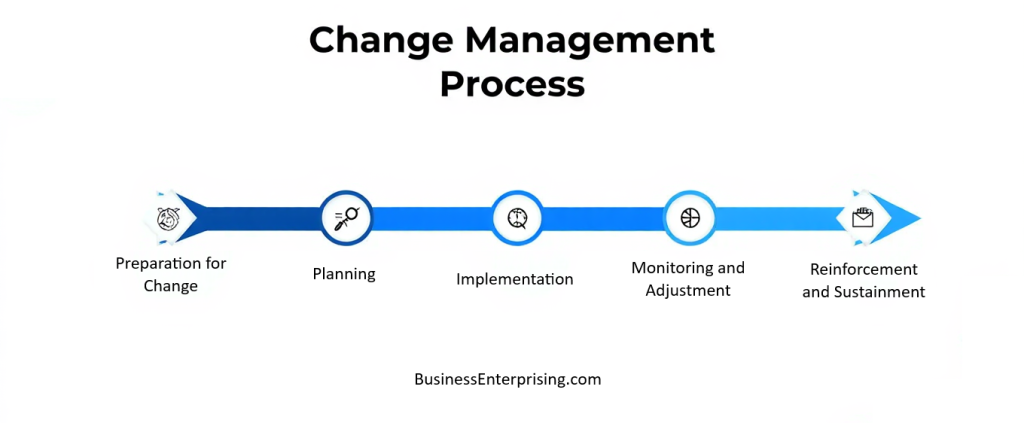
Additionally, people need time to adjust. When they don’t understand the reason for a change, they often push back. However, clear communication can ease those concerns. By explaining what’s happening and why, you help reduce resistance from the start.
Your team plays a big role in the outcome. Therefore, involve them early and ask for feedback along the way. When people feel included, they support the process more willingly. Additionally, they can help spot issues before they turn into bigger problems.
Planning matters, but so does follow-through. You can’t stop once the change goes live. Therefore, keep supporting your team even after the rollout. Regular check-ins and honest conversations can make a lasting difference.
However, not all change efforts succeed. Many fail due to poor communication or a lack of support. That’s why it’s important to stay engaged from start to finish. The more consistent your efforts, the more likely your team will adapt.
You don’t need to overcomplicate the process. Focus on being clear, prepared, and responsive. When people feel supported, they’re more open to change. As a result, your projects will run more smoothly and deliver stronger results.
What is change management?
Change management is a structured approach used to transition individuals, teams, and organizations from a current state to a desired future state.
Change management is a method used to guide people and teams through a shift from one way of working to another. It focuses on helping individuals adapt to new systems, processes, or company goals. Rather than forcing changes, it supports a smooth transition through structure and planning. The goal is to reduce confusion and keep progress on track.
You may already know that people resist change. That’s why the change management process includes communication, training, and feedback. By planning each step, you can help reduce disruptions to productivity. Additionally, it gives your team time to adjust to what’s coming. This makes change feel more manageable and less overwhelming.
Every organization faces change at some point. Therefore, having a process in place can make a difference in how people respond. Also, consistent leadership helps set expectations and reduce fear. Without clear direction, teams often struggle to stay focused during periods of change.
Additionally, change management helps build trust between leadership and employees. It shows that leadership values preparation, not chaos. When people understand why a change is happening, they are more likely to support it. As a result, you’ll see better performance and stronger engagement.
Finally, keep in mind that change doesn’t end when a new system goes live. Support must continue after the launch. Ongoing feedback and adjustments are just as important as the initial rollout. So, take the time to listen, adjust, and support your team throughout the process. You’ll see better results and less resistance along the way.
Why is change management important?
It helps minimize resistance, improve adoption, and ensure the successful implementation of organizational changes.
Change is a regular part of running a business. However, how you manage that change can affect your entire operation. Without a plan, people often resist new systems or processes. That resistance can delay progress or lower productivity.
The change management process helps you reduce that resistance and guide people through transitions. When you plan carefully, your team understands what’s happening and why. Additionally, they feel more supported and prepared to adjust. This can increase their willingness to accept the change.
You’ve probably seen how confusion spreads when communication is missing. Therefore, a clear process helps your team stay focused and engaged. It also helps your leaders send consistent messages and answer questions early. As a result, fewer people feel caught off guard by changes.
Additionally, planning helps you spot issues before they disrupt your timeline. You can identify gaps in training or tools that need updating. When you respond early, you avoid delays and keep your project moving. This saves both time and money.
It’s also worth noting that change impacts morale. However, when people feel involved and heard, they respond better to new expectations. That’s why feedback plays a big role in every step. Listen, adjust, and support your team. This keeps the change from becoming a source of frustration.
Finally, the change isn’t complete until it becomes part of daily work. Ongoing support helps people build new habits. Therefore, it’s important to follow through even after the main transition is done. With consistency, your team adapts faster and more effectively.
What are the key steps in the change management process?
The process typically includes preparing for change, managing the change, and reinforcing the change.
The change management process gives you a way to move your team from old habits to new practices. It’s not just about making a change. It’s about preparing people, supporting them, and helping the change stick. Without structure, changes often fall short of their goals.
First, you need to prepare for the change. That means identifying what’s changing and who it affects. Additionally, you should communicate clearly and early. People respond better when they understand the purpose. Therefore, share the reasoning and listen to feedback. This helps reduce resistance before it builds.
Next, you need to manage the actual change. This step involves training, support, and monitoring. As your team adopts new tools or processes, stay available to help. Also, be ready to answer questions. When you stay involved, people feel less overwhelmed and more confident.
However, the work doesn’t stop after the launch. You still need to reinforce the change. That means checking in with people regularly. Additionally, you may need to adjust training or clarify expectations. This step helps turn temporary efforts into lasting habits.
You can also track results to measure how well the change is working. If you notice gaps, take time to fix them. Therefore, stay flexible and keep communication open. These follow-ups help your team feel supported and stay on track.
Each part of the process builds on the last. When you approach change with a clear plan, your team can adapt faster. As a result, the change becomes part of everyday work instead of a short-term project.
Who is responsible for change management in an organization?
Leaders, change managers, and department heads all share responsibility for driving and supporting change efforts.
Change does not happen on its own. Someone has to lead the effort and guide others through it. That’s where responsibility comes in. Leaders, change managers, and department heads all play a role in driving results. Without support from the top, your change efforts can stall.
Leadership sets the tone for the entire organization. Therefore, they must show support and clearly communicate the goals. When senior leaders are engaged, others follow more easily. Additionally, their involvement builds trust and reduces doubt among staff. People need to see commitment, not just hear about it.
Change managers often take on the planning and day-to-day tasks. They create timelines, manage communication, and provide updates. However, they can’t do it alone. They need support from department heads who understand daily operations. These team leaders often explain the change in more detail. Therefore, they act as a bridge between upper leadership and staff.
You may also have a role to play. Even if you don’t lead the process, your feedback matters. Additionally, you can help your team adjust by staying positive and asking questions. Change becomes easier when everyone works together.
The change management process works best when responsibility is shared. One person can’t lead change across an entire organization. Therefore, collaboration is key. When each group plays its part, the effort gains momentum. As a result, your team is more likely to reach its goals.
How do you deal with resistance to change?
By communicating clearly, involving stakeholders early, and addressing concerns through active listening and support.
Resistance is one of the most common challenges you’ll face during change. People often feel unsure or worried about what’s next. However, how you respond to that resistance can make a big difference. Clear communication helps people feel more informed and less anxious.
Therefore, you should start early by explaining the change and why it matters. When people understand the reason, they’re more open to it. Additionally, invite questions and give honest answers. This shows that you respect their concerns and value their input.
Active listening is also key. Some people may just need to be heard. Others may need more support or training. Therefore, take time to learn what’s behind the resistance. You’ll often find it’s not the change itself, but the way it’s introduced.
Additionally, keep your tone steady and your message consistent. Changing your message midstream can add confusion. Instead, repeat the same key points and offer updates often. When you build trust, resistance begins to shrink.
The change management process includes steps for handling pushback. It’s not just about rolling out a new plan. It’s about helping people feel safe during the shift. Therefore, treat resistance as part of the process, not a problem.
You may not remove all resistance, but you can reduce it. By staying calm, listening carefully, and communicating clearly, you make the transition easier for everyone. As a result, your team will adapt faster and support the change with more confidence.
What are common reasons change initiatives fail?
They often fail due to poor communication, lack of leadership support, insufficient planning, or employee resistance.
Many change efforts fail even before they get off the ground. Often, the main problem is poor communication. When people don’t understand what’s happening, they hesitate to get on board. Therefore, confusion grows, and support fades.
Another reason change fails is lack of leadership support. If leaders stay silent, people question the change. Additionally, unclear direction makes the process harder to follow. When your team doesn’t hear from leadership, they often ignore the message entirely.
Insufficient planning also creates problems. You may launch a change too quickly without enough tools, training, or support. Therefore, employees feel unprepared and frustrated. Additionally, gaps in planning can lead to delays or expensive mistakes.
Resistance from employees can build over time. However, most people don’t resist just to be difficult. They resist because they’re unsure what the change means for them. Listening early and offering guidance can help reduce pushback. Therefore, address concerns before they grow.
The change management process helps you avoid these mistakes. It gives you a structure to follow and encourages regular communication. Additionally, it helps you assign roles, set timelines, and respond to concerns. Skipping this process often leads to failure.
You don’t need a perfect plan, but you do need a thoughtful one. Prepare, support your team, and stay involved. As a result, you’ll increase the chance of success and reduce the risk of failure.
Conclusion
Change can be hard, but having a clear plan makes it easier for everyone involved. You don’t have to do it alone. With the right support, your team can move forward without confusion or delay. Therefore, communication and preparation must come first.
Additionally, involving others early gives them time to adjust. When people feel heard, they’re more willing to participate. However, if you skip these steps, resistance often increases. That slows progress and creates frustration across your team.
The change management process helps you avoid common mistakes. It offers structure, support, and a path to better results. Therefore, use it as a tool, not just a checklist. It’s meant to guide decisions and keep your team on track.
Also, don’t stop after the launch. People need help adjusting even after the change goes live. Additionally, feedback helps you fix problems before they grow. Your team will notice when you stay involved, and they’ll respond more positively.
You don’t need a perfect rollout to succeed. However, you do need to stay present, clear, and supportive. Each step you take builds momentum and reduces confusion. Therefore, give your team time, tools, and attention throughout the process.
Keep your approach simple and steady. With clear communication, shared responsibility, and early planning, your team can handle change more easily. As a result, you’ll see better results and fewer setbacks.



